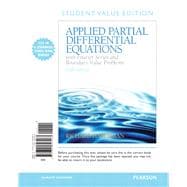
Note: Supplemental materials are not guaranteed with Rental or Used book purchases.
Purchase Benefits
What is included with this book?
Richard Haberman is Professor of Mathematics at Southern Methodist University, having previously taught at The Ohio State University, Rutgers University, and the University of California at San Diego. He received S.B. and Ph.D. degrees in applied mathematics from the Massachusetts Institute of Technology. He has supervised six Ph.D. students at SMU. His research has been funded by NSF and AFOSR. His research in applied mathematics has been published in prestigious international journals and include research on nonlinear wave motion (shocks, solitons, dispersive waves, caustics), nonlinear dynamical systems (bifurcations, homoclinic transitions, chaos), singular perturbation methods (partial differential equations, matched asymptotic expansions, boundary layers) and mathematical models (fluid dynamics, fiber optics). He is a member of the Society for Industrial and Applied Mathematics and the American Mathematical Society. He has taught a wide range of undergraduate and graduate mathematics. He has published undergraduate texts on Mathematical Models (Mechanical Vibrations, Population Dynamics, and Traffic Flow) and Ordinary Differential Equations.
The New copy of this book will include any supplemental materials advertised. Please check the title of the book to determine if it should include any access cards, study guides, lab manuals, CDs, etc.
The Used, Rental and eBook copies of this book are not guaranteed to include any supplemental materials. Typically, only the book itself is included. This is true even if the title states it includes any access cards, study guides, lab manuals, CDs, etc.